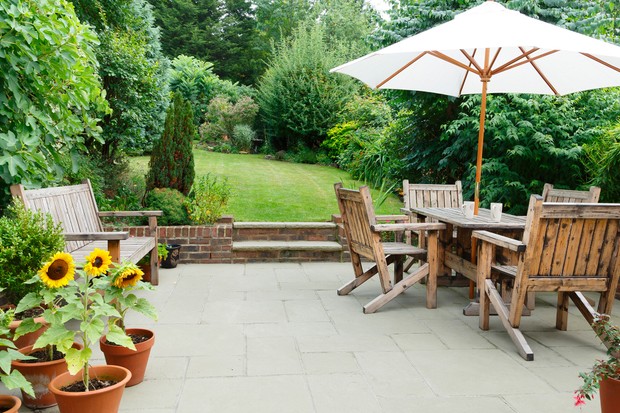
Gardens and planted areas in towns and cities are effective at absorbing rainwater and preventing soil erosion. Their ability to take up water reduces the amount that the drainage systems have to cope with and helps avoid flooding in and around our homes. With the government predicting that the severity of flood events is likely to worsen over the next few decades, and that they will become more frequent, it’s important that we use our gardens wisely to help prevent floods.
Too much paving

Removing planted borders and replacing them with large areas of paving affects the capacity of our gardens to absorb rainwater and increases the risk of flooding. If the majority of gardens in a road install impermeable paving (such as in front gardens to provide parking for cars) it can have a significant impact on the amount of surface runoff, which then increases the likelihood of flooding. But there are many types of permeable surfaces which minimise the impact on water absorption, such as grass reinforcement (protects grass from being damaged by vehicle wheels), permeable block pavers, or matrix (or cellular) pavers.
Removing areas between the paving provides space for planting pockets, which act as drainage areas. Low growing, resilient plants such as creeping thyme (Thymus serpyllum), heath pearlwort (Sagina subulata), Corsican mint (Mentha requienii) and creeping Jenny (Lysimachia nummularia) can be planted in these pockets to create interest and aid drainage. Another way to enable water to drain away is by using a permeable surface like gravel, which also provides areas for planting and a surface for car parking.
Not enough plants

Gardens with very few plants are more likely to have issues with flooding. Planted areas help water to filter into the ground so there is less runoff. Plants take up water and aerate the soil, enabling it to absorb more water. Evergreen plants require more water during the winter than deciduous plants, which will have lost their leaves, so it’s a good idea to include evergreens in your planting scheme to help absorb water all year round. One study suggested that hedges consisting of yew (Taxus baccata), Cotoneaster franchetii, privet (Ligustrum ovalifolium) and western red cedar (Thuja plicata) had a good ability to absorb water.
Some trees and shrubs have high rates of evapo-transpiration (how they take up water and release it into the atmosphere). These are useful to plant in areas prone to flooding and, according to the RHS, include species such as Forsythia x intermedia and hawthorn (Crataegus monogyna).
Hard, compacted soil
When soil becomes compacted, it significantly affects its ability to absorb water. Instead of draining away through the ground, water runs straight over the surface creating flooding problems. Avoid this problem by not walking on soil when it’s wet, avoiding using heavy machinery, and installing paths or stepping stones across lawns.
To improve the condition of soil that has already become compacted, aerate lawns using a garden fork or lawn aerator, switch to no-dig gardening, plant a green manure on bare ground, or add an organic mulch that will help break down the soil structure as it becomes incorporated into the existing soil.
Too many garden buildings

If your plot includes large areas dedicated to garden buildings such as sheds or home offices, it can exacerbate drainage issues and lead to flooding. This risk is worth considering before you add buildings to the garden, but if you already have lots of ground covered with buildings, try installing a green roof to help absorb rainwater before it comes in contact with the ground. Water butts are an excellent way to harvest rainwater from buildings and they providing a sustainable, free source of water for plants.
No water collection

A garden without water butts misses out on the opportunity to harvest rainwater. Water butts on a house can collect a large amount of water (24,000 litres or more a year) and there are many different sizes, including designs for small spaces and wall-mounted water butts. This prevents the need to use mains water for plants, and reduces the amount of rainwater that the earth needs to absorb, thereby helping to prevent flooding issues.
